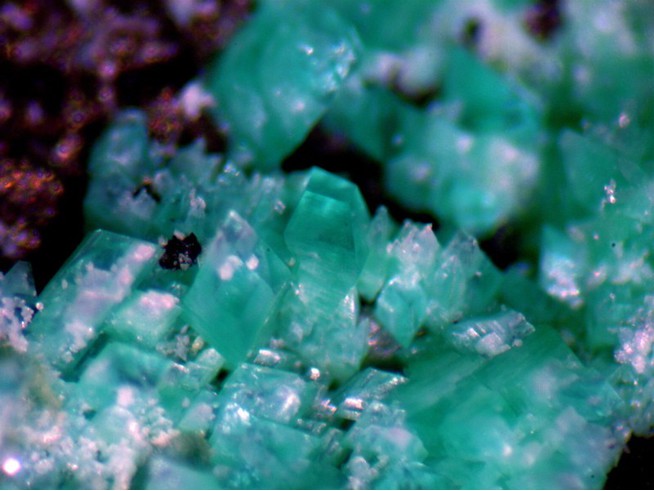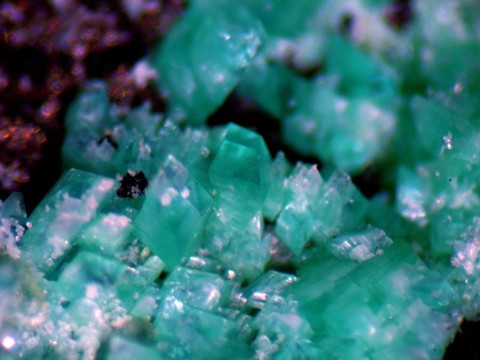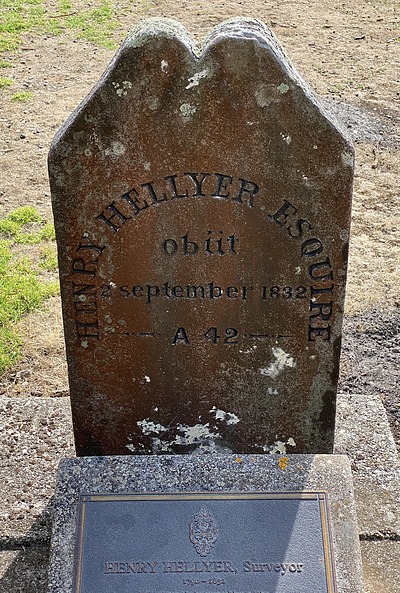Hellyerite
A valid IMA mineral species
This page is currently not sponsored. Click here to sponsor this page.
About Hellyerite
Formula:
NiCO3 · 5.5H2O
Colour:
Pale blue
Lustre:
Vitreous
Hardness:
2½
Specific Gravity:
1.97
Crystal System:
Monoclinic
Name:
In honour of Henry Hellyer (1791– September 2, 1832), first Surveyor-General of the Van Diemen’s Land Company and explorer of northwestern Tasmania.
Hellyerite is relatively unstable and, if not kept in an air-tight environment, the (originally) blue mineral decomposes in time to an X-ray amorphous, zaratite-like green phase, and other secondary nickel minerals (Anderson et al., 2002; Bottrill & Baker, 2008).
Unique Identifiers
Mindat ID:
1853
Long-form identifier:
mindat:1:1:1853:7
GUID
(UUID V4):
(UUID V4):
30b56a78-23fe-41cb-80e1-462ef2e3b1db
IMA Classification of Hellyerite
Classification of Hellyerite
5.CA.20
5 : CARBONATES (NITRATES)
C : Carbonates without additional anions, with H2O
A : With medium-sized cations
5 : CARBONATES (NITRATES)
C : Carbonates without additional anions, with H2O
A : With medium-sized cations
15.1.7.1
15 : HYDRATED NORMAL CARBONATES
1 : A(XO3)·xH2O
15 : HYDRATED NORMAL CARBONATES
1 : A(XO3)·xH2O
11.14.4
11 : Carbonates
14 : Carbonates of Co and Ni
11 : Carbonates
14 : Carbonates of Co and Ni
Mineral Symbols
As of 2021 there are now IMA–CNMNC approved mineral symbols (abbreviations) for each mineral species, useful for tables and diagrams.
| Symbol | Source | Reference |
|---|---|---|
| Hy | IMA–CNMNC | Warr, L.N. (2021). IMA–CNMNC approved mineral symbols. Mineralogical Magazine, 85(3), 291-320. doi:10.1180/mgm.2021.43 |
Physical Properties of Hellyerite
Vitreous
Transparency:
Transparent
Colour:
Pale blue
Hardness:
2½ on Mohs scale
Cleavage:
Perfect
One perfect and 2 good cleavages
One perfect and 2 good cleavages
Density:
1.97 g/cm3 (Measured) 1.98 g/cm3 (Calculated)
Optical Data of Hellyerite
Type:
Biaxial (-)
RI values:
nα = 1.455(2) nβ = 1.503(2) nγ = 1.549(2)
2V:
Measured: 85° , Calculated: 86°
Max Birefringence:
δ = 0.094

Image shows birefringence interference colour range (at 30µm thickness)
and does not take into account mineral colouration.
and does not take into account mineral colouration.
Surface Relief:
Low
Dispersion:
r > v distinct
Pleochroism:
Weak
Comments:
X = very pale greenish blue, Y = very pale greenish blue and Z = pale greenish blue.
Chemistry of Hellyerite
Mindat Formula:
NiCO3 · 5.5H2O
Elements listed:
Crystallography of Hellyerite
Crystal System:
Monoclinic
Class (H-M):
2/m - Prismatic
Space Group:
P2/m
Setting:
P2/m
Cell Parameters:
a = 10.769(2) Å, b = 7.295(2) Å, c = 9.343(2) Å
β = 94°
β = 94°
Ratio:
a:b:c = 1.476 : 1 : 1.281
Unit Cell V:
732.20 ų (Calculated from Unit Cell)
Z:
4
Twinning:
lamellar twinning occurs parallel to the perfect cleavage, individual twin lamellae ranging from 0.002 mm. to 0.03 mm. in width.
Comment:
synthetic
X-Ray Powder Diffraction
Powder Diffraction Data:
| d-spacing | Intensity |
|---|---|
| 9.4 Å | (100) |
| 6.06 Å | (100) |
| 3.65 Å | (70) |
| 3.40 Å | (60) |
| 2.38 Å | (50) |
| 3.11 Å | (40) |
| 2.78 Å | (40) |
Comments:
Lord Brassey mine, Tasmania, Australia. Data from type description.
Geological Environment
Paragenetic Mode(s):
| Paragenetic Mode | Earliest Age (Ga) |
|---|---|
| Stage 7: Great Oxidation Event | <2.4 |
| 47a : [Near-surface hydration of prior minerals] | |
| 47c : [Carbonates, phosphates, borates, nitrates] |
Type Occurrence of Hellyerite
General Appearance of Type Material:
Extremely fine-grained coatings up to 1.0 mm. thick.
Place of Conservation of Type Material:
Harvard University, Cambridge, Massachusetts, USA, 108400.
Geological Setting of Type Material:
Oxidation of nickel sulfides.
Associated Minerals at Type Locality:
Other Language Names for Hellyerite
German:Hellyerit
Spanish:Hellyerita
Common Associates
Associated Minerals Based on Photo Data:
| 12 photos of Hellyerite associated with Zaratite | Ni3(CO3)(OH)4 · 4H2O ? |
| 8 photos of Hellyerite associated with Heazlewoodite | Ni3S2 |
| 6 photos of Hellyerite associated with Reevesite | Ni6Fe3+2(OH)16(CO3) · 4H2O |
| 2 photos of Hellyerite associated with Serpentine Subgroup | D3[Si2O5](OH)4 |
| 2 photos of Hellyerite associated with Magnetite | Fe2+Fe3+2O4 |
| 1 photo of Hellyerite associated with Pentlandite | (NixFey)Σ9S8 |
Related Minerals - Strunz-mindat Grouping
| 5.CA.05 | Nesquehonite | MgCO3 · 3H2O |
| 5.CA.10 | Lansfordite | MgCO3 · 5H2O |
| 5.CA.15 | Barringtonite | MgCO3 · 2H2O |
Other Information
Health Risks:
No information on health risks for this material has been entered into the database. You should always treat mineral specimens with care.
Internet Links for Hellyerite
mindat.org URL:
https://www.mindat.org/min-1853.html
Please feel free to link to this page.
Please feel free to link to this page.
Search Engines:
External Links:
Mineral Dealers:
References for Hellyerite
Reference List:
Localities for Hellyerite
Locality List
 - This locality has map coordinates listed.
- This locality has map coordinates listed.
 - This locality has estimated coordinates.
ⓘ - Click for references and further information on this occurrence.
? - Indicates mineral may be doubtful at this locality.
- This locality has estimated coordinates.
ⓘ - Click for references and further information on this occurrence.
? - Indicates mineral may be doubtful at this locality.
 - Good crystals or important locality for species.
- Good crystals or important locality for species.
 - World class for species or very significant.
(TL) - Type Locality for a valid mineral species.
(FRL) - First Recorded Locality for everything else (eg varieties).
- World class for species or very significant.
(TL) - Type Locality for a valid mineral species.
(FRL) - First Recorded Locality for everything else (eg varieties).
All localities listed without proper references should be considered as questionable.
Australia (TL) | |
| American Mineralogist: 44: 533-538 +1 other reference |
Poland | |
| Karwowski et al. (2011) +1 other reference |
South Africa | |
| Cairncross et al. (1995) |
| Cairncross et al. (1995) |
Quick NavTopAbout HellyeriteUnique IdentifiersIMA Classification Classification Mineral SymbolsPhysical Properties Optical Data Chemistry Crystallography X-Ray Powder DiffractionGeological EnvironmentType Occurrence Other LanguagesCommon AssociatesStrunz-MindatOther InformationInternet Links References Localities Locality List







 symbol to view information about a locality.
The
symbol to view information about a locality.
The 



Lord Brassey Mine, Heazlewood district, Waratah-Wynyard municipality, Tasmania, Australia